

Hans Christian Ørsted. Hans Christian Ørsted (/ˈɜrstɛd/;[2] Danish: [hans kʰʁæsd̥jan ˈɶɐ̯sd̥ɛð]; often rendered Oersted in English; 14 August 1777 – 9 March 1851) was a Danish physicist and chemist who discovered that electric currents create magnetic fields, an important aspect of electromagnetism.
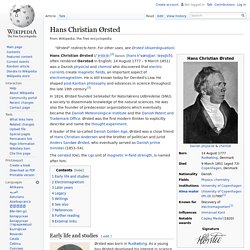
He is still known today for Oersted's Law. He shaped post-Kantian philosophy and advances in science throughout the late 19th century.[3] In 1824, Ørsted founded Selskabet for Naturlærens Udbredelse (SNU), a society to disseminate knowledge of the natural sciences. He was also the founder of predecessor organizations which eventually became the Danish Meteorological Institute and the Danish Patent and Trademark Office. Ørsted was the first modern thinker to explicitly describe and name the thought experiment. The oersted (Oe), the cgs unit of magnetic H-field strength, is named after him. Early life and studies[edit] Ørsted was born in Rudkøbing. Their conversations drew Ørsted into the study of physics. Hans Christian Ørsted. Un article de Wikipédia, l'encyclopédie libre.
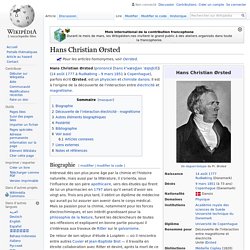
Pour les articles homonymes, voir Oersted. James Clerk Maxwell. James Clerk Maxwell FRS FRSE (13 June 1831 – 5 November 1879) was a Scottish[2][3] scientist in the field of mathematical physics.[4] His most notable achievement was to formulate the classical theory of electromagnetic radiation, bringing together for the first time electricity, magnetism, and light as different manifestations of the same phenomenon.
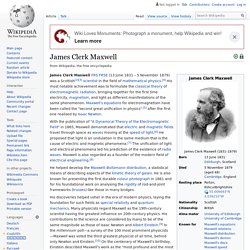
Maxwell's equations for electromagnetism have been called the "second great unification in physics" [5] after the first one realised by Isaac Newton. With the publication of "A Dynamical Theory of the Electromagnetic Field" in 1865, Maxwell demonstrated that electric and magnetic fields travel through space as waves moving at the speed of light.[6] He proposed that light is an undulation in the same medium that is the cause of electric and magnetic phenomena.[7] The unification of light and electrical phenomena led his prediction of the existence of radio waves.
Contents Life Early life, 1831–1839 Education, 1839–1847 ... Personal life Legacy. James Clerk Maxwell. Pour les articles homonymes, voir Maxwell. James Clerk Maxwell. Compléments James Clerk Maxwell (13 juin 1831 à Édimbourg en Écosse - 5 novembre 1879 à Cambridge en Angleterre) est un physicien et mathématicien écossais. Il est principalement connu pour avoir unifié en un seul ensemble d'équations, les équations de Maxwell, l'électricité, le magnétisme et l'induction, en incluant une importante modification du théorème d'Ampère.
Michael Faraday. English scientist Faraday's Laboratory at the Royal Institution (1870 engraving) Michael Faraday FRS (; 22 September 1791 – 25 August 1867) was an English scientist who contributed to the study of electromagnetism and electrochemistry.
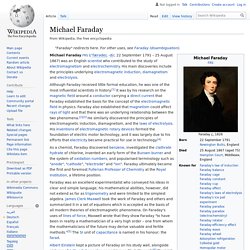
His main discoveries include the principles underlying electromagnetic induction, diamagnetism and electrolysis. Michael Faraday. Pour les articles homonymes, voir Faraday.
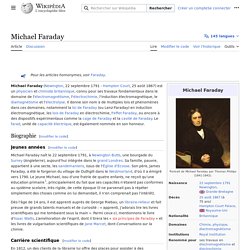
Portrait de Michael Faraday par Thomas Phillips (1841-1842). Signature. Hannes Alfvén. Education[edit] Alfvén received his PhD from the University of Uppsala in 1934.[2] His thesis was titled "Investigations of High-frequency Electromagnetic Waves.
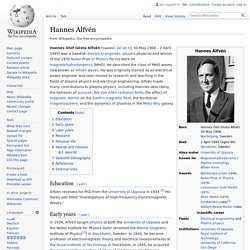
" Early years[edit] In 1934, Alfvén taught physics at both the University of Uppsala and the Nobel Institute for Physics (later renamed the Manne Siegbahn Institute of Physics[3]) in Stockholm, Sweden. In 1940, he became professor of electromagnetic theory and electrical measurements at the Royal Institute of Technology in Stockholm. Hannes Alfvén. Un article de Wikipédia, l'encyclopédie libre.
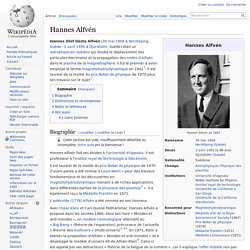
Hannes Alfvén en 1942 Hannes Olof Gösta Alfvén ( à Norrköping, Suède - à Djursholm, Suède) était un astrophysicien suédois qui étudia le déplacement des particules électrisées et la propagation des ondes d'Alfvén dans le plasma de la magnétosphère. Il fut le premier à avoir employé le terme magnétohydrodynamique en 1942[1]. Il est lauréat de la moitié du prix Nobel de physique de 1970 pour ses travaux sur le sujet[2]. Kristian Birkeland. Kristian Olaf Bernhard Birkeland (13 December 1867 – 15 June 1917) was a Norwegian scientist.
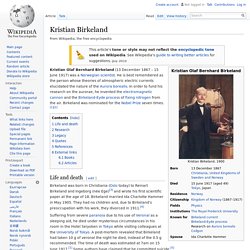
He is best remembered as the person whose theories of atmospheric electric currents elucidated the nature of the Aurora borealis. In order to fund his research on the aurorae, he invented the electromagnetic cannon and the Birkeland-Eyde process of fixing nitrogen from the air. Birkeland was nominated for the Nobel Prize seven times.[1][2] Life and death[edit] Courant de Birkeland. Un article de Wikipédia, l'encyclopédie libre.
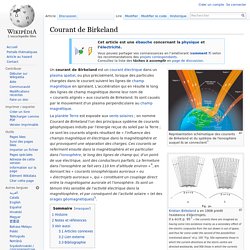
Représentation schématique des courants de Birkeland et du système de l'ionosphère auquel ils se connectent[1] Kristian Birkeland a en 1908 prédit l'existence d'électrojets. Il a écrit p. 95[2]« the currents there are imagined as having come into existence mainly as a secondary effect of the electric corpuscles from the sun drawn in out of space, and thus far come under the second of the possibilities mentioned above" et p. 105 "Fig. 50a represents those in which the current-directions at the storm-centre are directed westwards, and 50b those in which the currents move eastwards » Courants de type auroral tels que créés par Birkeland dans sa « terrella »[3], avec un globe magnétisé dans une chambre sous vide Un courant de Birkeland est un courant électrique dans un plasma spatial, ou plus précisément, lorsque des particules chargées dans le courant suivent les lignes de champ magnétique en spiralant.
Histoire[modifier | modifier le code] ↑ G. Kristian Birkeland. Un article de Wikipédia, l'encyclopédie libre.
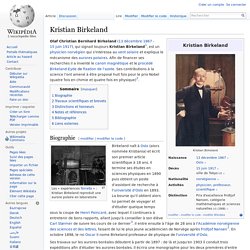
Kristian Birkeland Olaf Christian Bernhard Birkeland ( - ), qui signait toujours Kristian Birkeland[1], est un physicien norvégien qui s'intéressa au vent solaire et expliqua le mécanisme des aurores polaires. Mikamar Publishing. A voice for the Electric Universe. ThunderboltsProject. Looking for a fast track to comprehensive education on the Electric Universe? Those most eager to learn are invited to the EU Workshop, November 14-16, 2014 at the Sheraton Phoenix Downtown. This event will be led by Wal Thornhill and Dave Talbott, who are preparing full summaries of their life's work, something that has never been presented publicly.
Wal's talks will be complemented by additional material from electrical theorist Dr. Donald Scott, and Dave's presentations will be reinforced by Ev Cochrane, author of several essential books on the ancient sky. Seating will be limited. After much deliberation, we made the decision to release this full documentary. In Episode 2 Symbols of an Alien Sky: The Lightning Scarred Planet, Mars, David Talbott takes the viewer on an odyssey across the surface of Mars. Subscribe to Thunderbolts Update newsletter: Thunderbolts Project Home: Guide to the Electric Universe: Universe by Wal Thornhill: Universe T-shirts and Gifts: Show less.